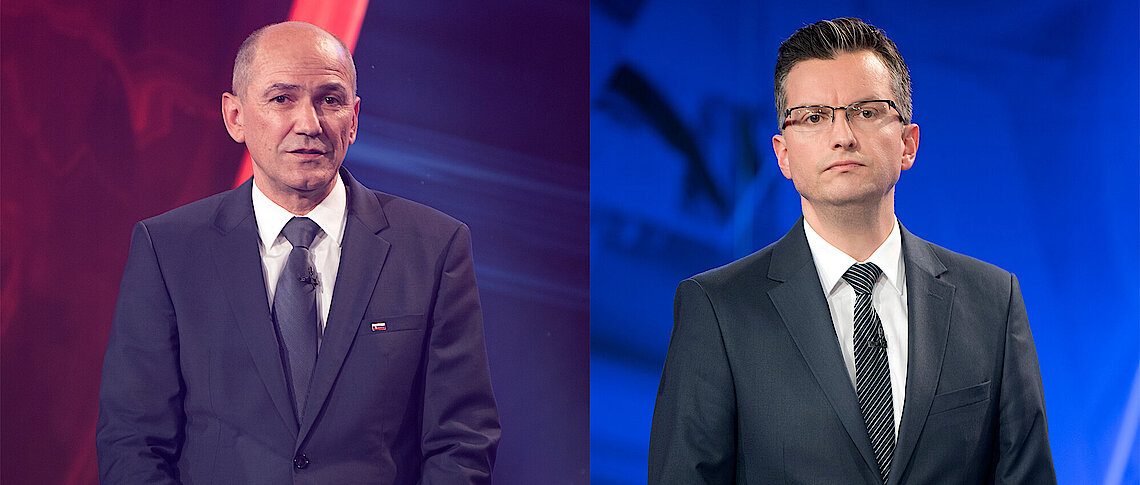Read this article in German or Russian.
The political shift to the right, noticeable in other European countries, has also not spared Slovenia. The anti-immigration party SDS, supported by the likes of Viktor Orban, has taken almost a quarter of the vote in the Slovenian parliamentary elections on 3 June 2018.
It seems, however, unlikely that the SDS and its frontrunner, Janez Janša, will be able to form a government. And then there's the surprise newcomer, former cabaret artist Marjan Šare, who came in second and without whom a government cannot be formed.
Max Brändle, director of the FES office in Zagreb, spoke to Hannes Alpen about the elections, possible coalitions and the fate of the Slovenian social democrats.
With former cabaret artist Marjan Šarec running as a populist outsider, the parliamentary elections in Slovenia brought back memories of Italy and the Five Star Movement. How did the election result turn out?
The Slovenian voters are highly unpredictable. This was already demonstrated in the last election in 2014. Law professor Miro Cerar, an outsider who founded his party only a few weeks before the election, won the election and went on to become prime minister. Now, former cabaret artist and current mayor of the small town of Kramnik, Marjan Šarec, came in second with 12 per cent behind right-wing conservative candidate Janez Janša. A government cannot be formed without Šarec. A right-winger and a newcomer from showbiz as winners of the election – this is indeed reminiscent of the situation in Italy. But there is a major difference. The main reason for the Slovenians’ right-leaning and experimental vote was not primarily that they were fed up with the traditional parties. The political system in Slovenia is not gummed up and set in its ways, it simply has not offered the roughly 20 per cent of voters outside of the traditional blocks any reliable options until now. Like in 2011, Janez Janša once again mobilised the right wing to support his candidacy, winning 25 per cent of the votes. With five parties impeding each other on the left, the Social Democrats (SD) managed to come out on top with just under 10 per cent, four percentage points more than in the last election. The voters in the centre are still keen to experiment. Last time, it was lawyer Miro Cerar who won them over, and this time it was Marjan Šarec, the man they knew from TV.
Viktor Orban travelled to Slovenia to support the right wing’s election campaign. Did that affect the election?
The heavy mobilisation for the right wing, which helped Janez Janša win almost 25 per cent of the vote, can certainly be attributed to Viktor Orban’s support for the campaign. Orban spoke at the convention of Janša’s SDS party on 11 May 2018 and appealed to the voters to give him their vote. His election would “save the Slovenian people”, Orban said. The fear of migrants and support from Hungary allowed Janša to win over voters. However, this right-wing potential is almost completely exhausted with roughly a quarter of the voters. The majority of Slovenians do not envisage their country’s future as an isolationist nation or one that stands shoulder to shoulder with the Visegrad Group. They rather identify with Western Europe, distancing themselves from former Yugoslavia and East Central Europe.
What about the election result of the Social Democrats?
It was a close shave for the SD, but they just managed to avoid ending up in fourth place. They are now third behind right-wing Janez Janša and newcomer Marjan Šarec, and almost head to head with former prime minister Miro Cerar. They had expected a better outcome. Now the party could end up in a similar situation to that of the SPD last autumn. Many are eager to take on the role of opposition leader for fear of otherwise being annihilated in a multi-party coalition. Others are expecting a new election to take place soon anyway and consider it a mistake to prevent the formation of a coalition against the right wing. But there is one piece of good news: The SD increased its result by four percentage points and is the only party in the governing coalition to improve, coming in ahead of the other centre-left parties. Party leader Dejan Židan will be able to sell this result as a success and partial victory, while already having to think ahead to the next election campaign.
What kind of government constellation can we expect after these election results?
With these results, at least three parties are needed to form a coalition: Janša’s SDS + Šarec’s LMS + the Christian democratic NSi. Based on what Marjan Šarec said during the election campaign, however, it is unlikely that such a right-wing alliance will be formed. It is more likely that Šarec will aim for the office of prime minister from his second-place position rather than help Janša, who achieved twice as many votes, into office. Such a left-wing coalition of five parties – Šarec’s LMS + SD + Miro Cerar’s SMC + Democratic Party of Pensioners of Slovenia (DeSUS) + Left Party Levica or, alternatively, Alenka Bratušek’s SAB – will be fragile and prone to crises from the outset. The probability of snap elections would be very high in this scenario. With the deck reshuffled and the Slovenian voters being so volatile and happy to experiment, the outcome would, once again, be completely open.






